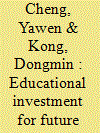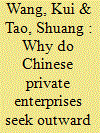|
|
|
Sort Order |
|
|
|
Items / Page
|
|
|
|
|
|
|
| Srl | Item |
| 1 |
ID:
193004


|
|
|
|
|
| Summary/Abstract |
Numerous studies have shown that a sex ratio imbalance (more boys than girls in a society) may result in a sequence of social problems. This study investigated the expected effect of a high sex ratio on educational investment. Using nationally representative data from the China Family Panel Studies and the 2010 Census, we determined the following: (i) a high sex ratio increased educational expenditure for boys relative to girls; (ii) parents who took education seriously and who cared about their children's education were more likely to invest in education to appear attractive in the future marriage market, and (iii) the profound impact of a high sex ratio on educational expenditure was more pronounced in less educated and poorer families. Our findings raised the possibility that the effect of the sex ratio may bring about more gender inequality in the future. The implicit cost of a high sex ratio may further lead to a vicious cycle of family fertility and childbearing.
|
|
|
|
|
|
|
|
|
|
|
|
|
|
|
|
| 2 |
ID:
193002


|
|
|
|
|
| Summary/Abstract |
This study examines how individuals' fertility outcomes were affected by the labor market conditions they experienced at graduation. Using data from the Chinese General Social Survey, it finds that poor labor market conditions at graduation delayed individuals' entry into parenthood. Higher unemployment rates at graduation reduced the probability of having at least one child in the survey year for both men and women. The negative fertility effects generally followed a U-shape, reached the maximum around average childbearing ages, and faded out within 15 years after graduation. Low-skilled workers mainly contribute to the negative fertility effects observed in the whole sample. Employment and marital outcomes are also analyzed as potential mechanisms. Estimation results indicate that individuals who experienced poor labor market conditions at graduation delayed marriage and the birth of the first child due to a lower probability of being employed, reduced working hours, and adverse income shocks. The negative long-term fertility effects should be brought to policymakers' attention, especially when China's low fertility issue worsens. Policymakers are expected to create more favorable employment conditions for labor market entrants to encourage fertility and expand the future working-age population.
|
|
|
|
|
|
|
|
|
|
|
|
|
|
|
|
| 3 |
ID:
193000


|
|
|
|
|
| Summary/Abstract |
The economic impact of the geographical rotation of local officials is important in China's official management system. This study used a zero-inflated Poisson regression model and found that the geographical rotation of local officials significantly increased cross-city mergers and acquisitions (M&As) of enterprises. The impact of local officials' geographical rotation on M&As was more pronounced under certain conditions. These conditions included: (i) when officials were transferred from cities with a higher development level to cities with a lower development level; (ii) when the outflow cities were municipalities directly governed by the central government, provincial capitals, or separately listed cities; (iii) when the transfers of officials occurred within the same province; (iv) when the transfers took place before 2012; and (v) when the transfers happened in the years following significant central government conferences, which provided strong political incentives for M&As.
|
|
|
|
|
|
|
|
|
|
|
|
|
|
|
|
| 4 |
ID:
193003


|
|
|
|
|
| Summary/Abstract |
To investigate whether industrial robots have improved the ecological environment, this study integrated the adoption of robot technology and pollution abatement into Melitz's heterogeneous firm model. This showed that using robots in production can lower firms' pollution intensity by increasing their abatement investments, and this reduction effect is greater for higher polluting firms and those subject to weaker local environmental regulations. These theoretical expectations were then confirmed through a series of empirical investigations based on Bartik instrument regressions, with multiple robustness checks as well as heterogeneity and mechanism analyses. This paper adds to the literature on the relationships between automation technologies and green transformation. It shows that in the pursuit of economic growth and environmental protection, it is necessary for policymakers to shift from pollution control to technical support for traditional manufacturing firms.
|
|
|
|
|
|
|
|
|
|
|
|
|
|
|
|
| 5 |
ID:
192999


|
|
|
|
|
| Summary/Abstract |
This study examined the impact of inquiry letters on corporate tax aggressiveness based on the special inquiry system in Chinese stock exchanges. It found that the receipt of inquiry letters significantly inhibited tax aggressiveness. The channel through which inquiry letters worked involved a monitoring effect on related-party transactions. The disincentive effect of inquiry letters on corporate tax aggressiveness was mainly found in firms with overseas operations, low-quality of internal control, and weak tax enforcement. Examining the textual information in inquiry letters, the results show that more questions and the demand for a specific opinion from the auditor led to a greater disincentive effect. The level of detail in firms' reply letters weakened this disincentive effect. Finally, the disincentive effect of tax aggressiveness was more pronounced when inquiry letters pointed to tax-related issues.
|
|
|
|
|
|
|
|
|
|
|
|
|
|
|
|
| 6 |
ID:
193001


|
|
|
|
|
| Summary/Abstract |
The relationship between air pollution and charitable donations of companies has received little attention from academia. To make up for this defect, we use a regression discontinuity design based on the spatial discontinuity in air pollution created by China's winter heating policy in the north of Qinling Mountains–Huai River line to examine whether severe air pollution may cause polluting companies to make charitable donations. Our results consistently show that air pollution has a positive impact on the donations of polluting companies, regardless of whether the absolute donations, the relative donations, or the willingness to donate are used to measure donations. A series of robustness tests confirm that this relationship is causal. Furthermore, we find that under severe air pollution, the motivations of polluting companies to implement donation behaviors are to decrease the probability of environmental penalties, reduce environmental pollution costs, and decrease the extent to which air pollution affects company reputations.
|
|
|
|
|
|
|
|
|
|
|
|
|
|
|
|
| 7 |
ID:
192998


|
|
|
|
|
| Summary/Abstract |
This paper examines the effects of China's accelerated depreciation policy (ADP) on the maturity mismatch between investment and financing. Using panel data for China's A-share nonfinancial listed companies from 2010 to 2019 and a staggered difference-in-differences approach, we found the following. First, ADP significantly aggravated the degree of corporate maturity mismatch, and this result was robust across multiple checks. Second, due to an insufficient long-term loan supply, firms had to finance the fixed investments induced by ADP with short-term debts, leading to maturity mismatches. Third, the positive policy effects were mainly significant for firms with high policy exposure, high-risk preferences, a high degree of information asymmetry, and firms with weak long-term financing capacity. Finally, maturity mismatch exacerbated corporate financial risks. Our research findings indicate that passive maturity mismatch is prevalent among Chinese companies and emphasize the need to address financial repression in order to mitigate the potential financial risks that may arise from tax incentives.
|
|
|
|
|
|
|
|
|
|
|
|
|
|
|
|
| 8 |
ID:
193005


|
|
|
|
|
| Summary/Abstract |
China is currently in a period of economic transformation and the reform of the factor market still lags behind that of the product market. This study explores the reasons causing China's private enterprise to expand abroad from the perspective of domestic factor market imperfection. Using data for Chinese listed firms between 2002 and 2020, it examines whether outward foreign direct investment (OFDI) has been undertaken by private enterprises as a response to domestic factor market imperfection. It finds that private enterprises located in regions with greater factor market imperfection have had a greater tendency to engage in OFDI. This effect has been more pronounced among firms with high productivity or high innovation capability, and among medium and small private enterprises.
|
|
|
|
|
|
|
|
|
|
|
|
|
|
|
|
|
|
|
|
|